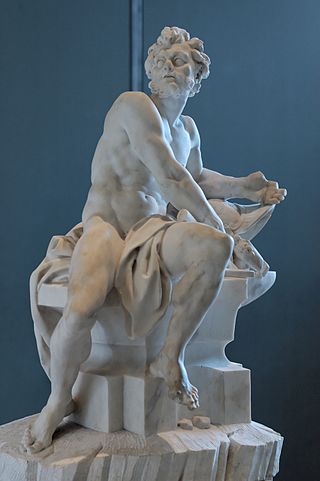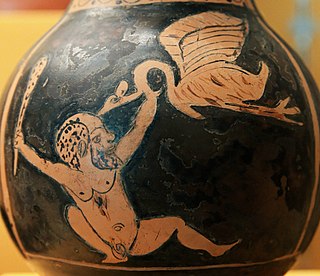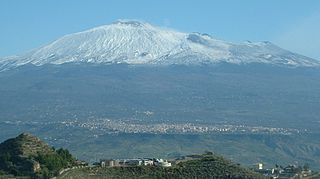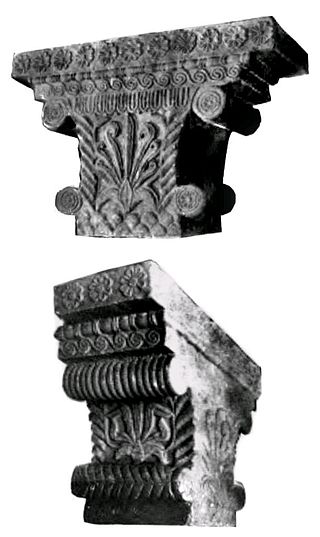Related Research Articles

Aelianus Tacticus, also known as Aelian, was a Greek military writer who lived in Rome.

Hephaestus is the Greek god of artisans, blacksmiths, carpenters, craftsmen, fire, metallurgy, metalworking, sculpture and volcanoes. Hephaestus's Roman counterpart is Vulcan. In Greek mythology, Hephaestus was either the son of Zeus and Hera or he was Hera's parthenogenous child. He was cast off Mount Olympus by his mother Hera because of his lameness, the result of a congenital impairment; or in another account, by Zeus for protecting Hera from his advances.

In ancient Greek mythology and religion, Leto is a goddess and the mother of Apollo and Artemis. She is the daughter of the Titans Coeus and Phoebe, and the sister of Asteria.

Zeus is the sky and thunder god in ancient Greek religion and mythology, who rules as king of the gods on Mount Olympus. His name is cognate with the first syllable of his Roman equivalent Jupiter.

In ancient Greek religion and mythology, Pan is the god of the wild, shepherds and flocks, rustic music and impromptus, and companion of the nymphs. He has the hindquarters, legs, and horns of a goat, in the same manner as a faun or satyr. With his homeland in rustic Arcadia, he is also recognized as the god of fields, groves, wooded glens, and often affiliated with sex; because of this, Pan is connected to fertility and the season of spring.
The Minyades were three Orchomenian (Arcadian) princesses in Greek mythology. These sisters were protagonists of a myth about the perils of neglecting the worship of Dionysus.

Mount Etna, or simply Etna, is an active stratovolcano on the east coast of Sicily, Italy, in the Metropolitan City of Catania, between the cities of Messina and Catania. It is located above the convergent plate margin between the African Plate and the Eurasian Plate. It is one of the tallest active volcanoes in Europe, and the tallest peak in Italy south of the Alps with a current height of 3,369 m (11,053 ft), though this varies with summit eruptions. Over a six-month period in 2021, Etna erupted so much volcanic material that its height increased by approximately 100 ft (30 m), and the southeastern crater is now the tallest part of the volcano.

Attis was the consort of Cybele, in Phrygian and Greek mythology.

In Greek mythology, the mountainous district of Nysa, variously associated with Ethiopia, Libya, Boeotia, Thrace, India, or Arabia by Greek mythographers, was the traditional place where the rain nymphs, the Hyades, raised the infant god Dionysus, the "God of Nysa."
Agrotera was an epithet of the Greek goddess Artemis, the most important goddess to Attic hunters.
In Greek mythology, Anapus was god of the river Anapus in eastern Sicily. He was worshiped by the Syracusans, who depicted him as a young man. Anapus was husband to the naiad Cyane, who attempted to dissuade Hades from abducting Persephone, describing how she consented to Anapus' wooing out of love, rather than force.

Gerana, sometimes also called Oenoe, is a queen of the Pygmy folk in Greek mythology, who incurred the wrath of the goddess Hera and was subsequently turned into a bird bearing her name, the crane. This aetiological tale explains the ancient rivalry between the Pygmies and the cranes, and also serves as a cautionary tale against the people who hubristically claimed to be better than even the gods themselves. Gerana's story bears some resemblance to that of Lamia, who was also a beautiful woman cursed by Hera and transformed into something unappealing.
Aesymnetes was an epithet of the Greek god Dionysus, which signifies the "Lord", or "Ruler", and under which he was worshipped at Aroë in Achaea.
Aetna was in Greek and Roman mythology a Sicilian nymph and, according to Alcimus, a daughter of Uranus and Gaia or of Briareus. Stephanus of Byzantium says that according to one account Aetna was a daughter of Oceanus. Simonides said that she had acted as arbitrator between Hephaestus and Demeter respecting the possession of Sicily. By Zeus or Hephaestus she became the mother of the Palici.
Aetnaeus was an epithet given to several Greek and Roman gods and mythical beings connected with Mount Aetna, such as Zeus, of whom there was a statue on Mount Aetna, and to whom a festival was celebrated there, called Aetnaea, Hephaestus, who had his workshop in the mountain, and a temple near it, and the Cyclops.
Bistones is the name of a Thracian people who dwelt between Mount Rhodopé and the Aegean Sea, beside Lake Bistonis, near Abdera extending westward as far as the river Nestus. It was through the land of the Bistones that Xerxes marched on his invasion of Greece. The Bistones continued to exist at the time when the Romans were masters of Thrace. Roman poets sometimes use the names of the Bistones for that of the Thracians in general. Pliny mentions one town as belonging to the Bistones: Tirida; the other towns on their coast, Dicaea, Ismaron, Parthenion, Phalesina and Maronea, were Greek colonies.
In Greek mythology, Nerites was a minor sea deity, the son of "Old Man of the Sea" Nereus and the Oceanid Doris and brother of the fifty Nereids. He was described as a young boy of stunning beauty. According to Aelian, although Nerites was never mentioned by epic poets such as Homer and Hesiod he was a common figure in the mariners' folklore nevertheless.

Adranon or Adranos, present day Adrano, was an ancient polis of Magna Graecia on the southwestern slopes of Mount Etna, near Simeto River.
Arbius was a toponymic epithet of the Greek god Zeus, derived from Mount Arbias in Crete – in modern times, the hills and chasms near Arvi – where he was worshipped.

For the ancient Greeks, “India" referred to the polity situated east of Persia and south of the Himalayas. Although, during different periods of history, "India" referred to a much wider or much less extensive place.
References
- ↑ Plutarch, Timoleon 12
- ↑ Diodorus Siculus, xiv. 37
- ↑ Aelian, Hist. Anim. xi. 20
- ↑ Schmitz, Leonhard (1867), "Adranus", in Smith, William (ed.), Dictionary of Greek and Roman Biography and Mythology , vol. 1, Boston, p. 20, archived from the original on 2005-12-18, retrieved 2007-10-15
{{citation}}: CS1 maint: location missing publisher (link)
